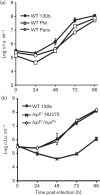The novel Legionella pneumophila type II secretion substrate NttC contributes to infection of amoebae Hartmannella vermiformis and Willaertia magna
- PMID: 25253612
- PMCID: PMC4252911
- DOI: 10.1099/mic.0.082750-0
The novel Legionella pneumophila type II secretion substrate NttC contributes to infection of amoebae Hartmannella vermiformis and Willaertia magna
Abstract
The type II protein secretion (T2S) system of Legionella pneumophila secretes over 25 proteins, including novel proteins that have no similarity to proteins of known function. T2S is also critical for the ability of L. pneumophila to grow within its natural amoebal hosts, including Acanthamoeba castellanii, Hartmannella vermiformis and Naegleria lovaniensis. Thus, T2S has an important role in the natural history of legionnaires' disease. Our previous work demonstrated that the novel T2S substrate NttA promotes intracellular infection of A. castellanii, whereas the secreted RNase SrnA, acyltransferase PlaC, and metalloprotease ProA all promote infection of H. vermiformis and N. lovaniensis. In this study, we determined that another novel T2S substrate that is specific to Legionella, designated NttC, is unique in being required for intracellular infection of H. vermiformis but not for infection of N. lovaniensis or A. castellanii. Expanding our repertoire of amoebal hosts, we determined that Willaertia magna is susceptible to infection by L. pneumophila strains 130b, Philadelphia-1 and Paris. Furthermore, T2S and, more specifically, NttA, NttC and PlaC were required for infection of W. magna. Taken together, these data demonstrate that the T2S system of L. pneumophila is critical for infection of at least four types of aquatic amoebae and that the importance of the individual T2S substrates varies in a host cell-specific fashion. Finally, it is now clear that novel T2S-dependent proteins that are specific to the genus Legionella are particularly important for L. pneumophila infection of key, environmental hosts.
© 2014 The Authors.
Figures





Similar articles
-
Multiple Legionella pneumophila Type II secretion substrates, including a novel protein, contribute to differential infection of the amoebae Acanthamoeba castellanii, Hartmannella vermiformis, and Naegleria lovaniensis.Infect Immun. 2013 May;81(5):1399-410. doi: 10.1128/IAI.00045-13. Epub 2013 Feb 19. Infect Immun. 2013. PMID: 23429532 Free PMC article.
-
Type II Secretion-Dependent Aminopeptidase LapA and Acyltransferase PlaC Are Redundant for Nutrient Acquisition during Legionella pneumophila Intracellular Infection of Amoebas.mBio. 2018 Apr 17;9(2):e00528-18. doi: 10.1128/mBio.00528-18. mBio. 2018. PMID: 29666285 Free PMC article.
-
Nuclease activity of Legionella pneumophila Cas2 promotes intracellular infection of amoebal host cells.Infect Immun. 2015 Mar;83(3):1008-18. doi: 10.1128/IAI.03102-14. Epub 2014 Dec 29. Infect Immun. 2015. PMID: 25547789 Free PMC article.
-
Type II secretion and Legionella virulence.Curr Top Microbiol Immunol. 2013;376:81-102. doi: 10.1007/82_2013_339. Curr Top Microbiol Immunol. 2013. PMID: 23900831 Review.
-
[Intra-amoebal development of Legionella pneumophila and the potential role of amoebae in the transmission of Legionnaires' disease].Med Mal Infect. 2006 Apr;36(4):196-200. doi: 10.1016/j.medmal.2005.10.010. Epub 2006 Feb 3. Med Mal Infect. 2006. PMID: 16459041 Review. French.
Cited by
-
The Legionella pneumophila Siderophore Legiobactin Is a Polycarboxylate That Is Identical in Structure to Rhizoferrin.Infect Immun. 2015 Oct;83(10):3937-45. doi: 10.1128/IAI.00808-15. Epub 2015 Jul 20. Infect Immun. 2015. PMID: 26195554 Free PMC article.
-
Expanding Role of Type II Secretion in Bacterial Pathogenesis and Beyond.Infect Immun. 2017 Apr 21;85(5):e00014-17. doi: 10.1128/IAI.00014-17. Print 2017 May. Infect Immun. 2017. PMID: 28264910 Free PMC article. Review.
-
Amoebae as Targets for Toxins or Effectors Secreted by Mammalian Pathogens.Toxins (Basel). 2021 Jul 28;13(8):526. doi: 10.3390/toxins13080526. Toxins (Basel). 2021. PMID: 34437397 Free PMC article. Review.
-
F. novicida-Infected A. castellanii Does Not Enhance Bacterial Virulence in Mice.Front Cell Infect Microbiol. 2016 May 18;6:56. doi: 10.3389/fcimb.2016.00056. eCollection 2016. Front Cell Infect Microbiol. 2016. PMID: 27242974 Free PMC article.
-
Amoebae as training grounds for microbial pathogens.mBio. 2024 Aug 14;15(8):e0082724. doi: 10.1128/mbio.00827-24. Epub 2024 Jul 8. mBio. 2024. PMID: 38975782 Free PMC article. Review.
References
Publication types
MeSH terms
Substances
Grants and funding
LinkOut - more resources
Full Text Sources
Other Literature Sources
Molecular Biology Databases

